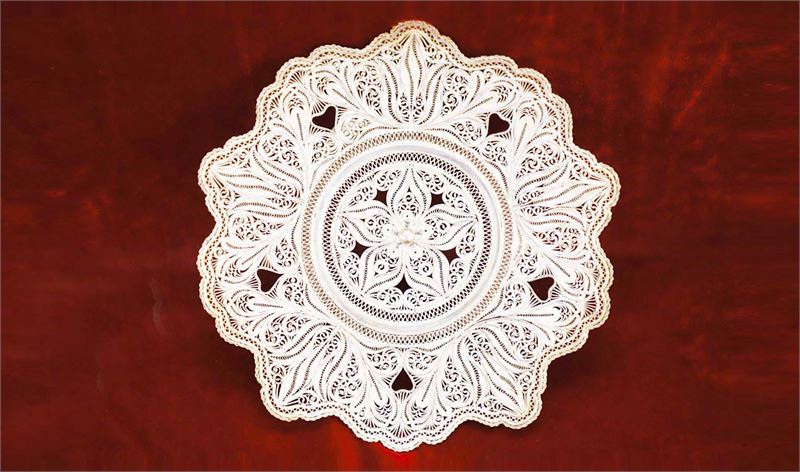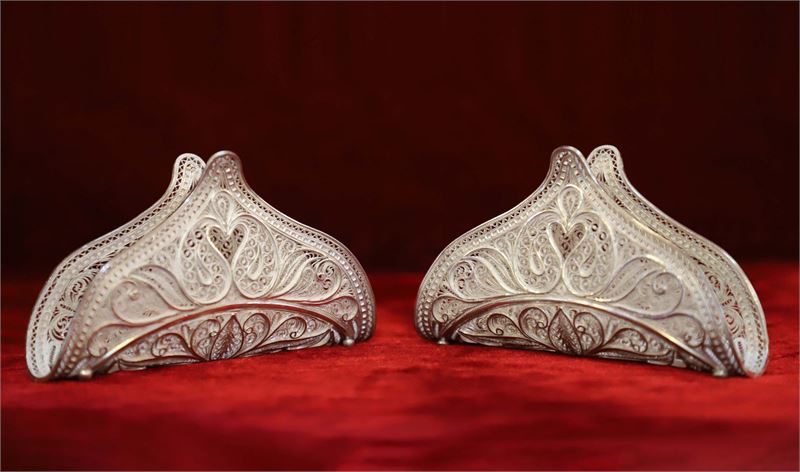According to documents obtained from archaeological discoveries, the oldest objects that indicate the origins of malileh in Iran date back to the Achaemenid period.
During the Sasanian era, metalworkers and silversmiths crafted expensive vessels and beautiful jewelry for the affluent classes of their society. In some cases, they adorned these items with precious stones, which added a special charm to the created pieces.
Unfortunately, during the Arab invasion of Iran, many artworks were taken as spoils due to their high value and portability.
Currently, we do not have much evidence of those artworks from the mentioned historical period. What has been discovered, mostly by chance, in regions like Susa, Hamadan, and the Jeyhun treasure through the efforts of archaeologists over the past few centuries, traces the art of malileh in Iran back to pre-Christian times.

Zanjan is home to renowned and skilled masters of malileh art. Mr. Mohammad Hossein Sattari, as the head of the Zanjan Malileh House, is one of the distinguished experts in this art form.
In historical books that have referenced Zanjan, the metalworking industry is mentioned more than anything else. Since the art of malileh is a branch of metalworking, it can be traced within the path of this craft.
Metalworking in the city of Zanjan experienced significant development and prosperity during the Achaemenid, Parthian, and Sassanian periods.
Tea trays and sets, jewelry boxes, decorative bowls and baskets, and knife handles have been the main products produced from the past to the present. The silver used in this art is 100% pure and of high quality.
The process of making malileh begins by hammering or rolling silver ingots into thin square wires. These wires are then shaped into small patterns, which are placed together in a mold and soldered with lower-grade silver to hold them in place.

A pedestal dessert plate with a tulip and tendril design, 20 centimeters in diameter and 5 centimeters in height.
The tools used in malileh work are similar to those used in jewelry making. To create malileh pieces, one must first prepare the malileh strips from gold, silver, or copper. This involves passing a silver ingot or wire through a rolling mill and then through a drawplate to obtain the desired wire. After that, the process of making the malileh begins as described below.
First, a sheet of iron is prepared as the base, in various dimensions, from a wire plate. The surface of the iron sheet is then coated with wax to form a layer of wax about 1.5 to 2.5 millimeters thick. After that, a mold that matches the desired product's shape is placed on the wax-coated iron base.
In the second step, a strip that is wider than the wire strip is placed around the mold to take on its shape, and it is then pressed into the wax.
Afterward, the wax is melted and removed. Once the wax is separated, solder is applied to the work, and by heating it, the solder melts and bonds the filigree pieces together.

A square, pedestal chocolate box with a lid, featuring a closed tulip design and a flat base, measuring 15 by 15 centimeters.
In the fourth step, the iron wires are removed, and the piece is boiled in a diluted solution of sulfuric acid with water or a solution containing "Za’ghab," which is a mixture of white and blue alum, to remove any excess silver stains.
Finally, it is cleaned with fine wire brushes, and any irregularities on the walls of the malileh are smoothed out using jeweler's files, sandpaper, and a burnishing tool.
The art of malileh features a variety of designs, including traditional patterns such as paisley (boteh jegheh), foreign leaves (barg-e farang), buds (ghoncheh), tendrils (pichak), and three or four-eyed motifs, which are commonly used in this craft.
According to most researchers, the oldest examples of Iranian malileh artifacts date back to the years 330 to 550 B.C.

A jewelry box with a heart-shaped design, entirely traditional with a smooth silver lining inside the box to conceal the jewelry. It also contains a pair of malileh earrings with a "charouq" design inside the box.
Malileh art in Zanjan is a traditional craft with a long history. In 2019, UNESCO designated Zanjan as a world city of malileh art.
Zanjan is home to renowned and skilled masters of malileh art. Mr. Mohammad Hossein Sattari, as the head of the Zanjan Malileh House, is one of the distinguished experts in this art form.
With 36 years of experience in malileh art and 28 years of teaching and transferring malileh skills to enthusiasts, he has been dedicated and committed to preserving and promoting this intangible heritage. This text is derived from an exclusive interview with him.
Mohammad Hossein Sattari has created numerous works in the art of malileh, and one of his pieces is housed in the Museum of the Holy Shrine of Imam Reza in Iran.

A one-piece tabletop napkin holder with a paisley design and curved edges, measuring 12 centimeters in length and 8 centimeters in width.
Here, Zanjan is a passage through history...
-------------------
Written by Mr. Akbar Karimi, the international reporter for Arirang Culture Connect and the Founder and Managing Director of the Samte Ganjineye Ghoghnoos Cultural-Artistic Institute in Iran. His leadership in preserving and promoting Iranian intangible cultural heritage, along with his extensive experience in cultural-artistic research and his active participation in international forums such as UNESCO and ICCN, enriches his contributions to the global cultural dialogue.
Translated by Mrs. Farnaz Seydi, the director of international relations of Samte Ganjineye Ghoghnoos Institute.